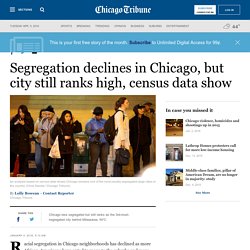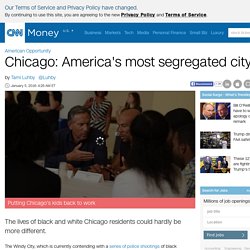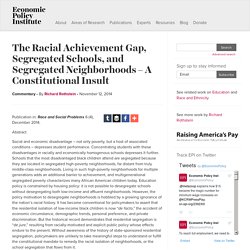

Segregation declines in Chicago, but city still ranks high, census data show. Racial segregation in Chicago neighborhoods has declined as more African-Americans have opted to move to the suburbs and more whites and Latinos have moved into historically black communities, an analysis based on new census data shows.

Detroit’s white population rises. Detroit’s white population rose by nearly 8,000 residents last year, the first significant increase since 1950, according to a Detroit News analysis of U.S.

Census Bureau data. The data, made public Wednesday, mark the first time census numbers have validated the perception that whites are returning to a city that is overwhelmingly black and one where the overall population continues to shrink. Many local leaders contend halting Detroit’s population loss is crucial, and the new census data shows that policies to lure people back to the city may be helping stem the city’s decline. Chicago: America's most segregated city - Jan. 5, 2016. The Windy City, which is currently contending with a series of police shootings of black Chicagoans, is the most segregated major metro area in the nation.

And it's been in the top 3 in terms of segregation for many years, according to the Voorhees Center for Neighborhood and Community Improvement at the University of Illinois at Chicago. In Chicago, blacks and whites live clustered in separate parts of the city. In fact, some 72% of black or white residents would have to move to a different census tract to even out the numbers, according to a commonly used segregation measure called the index of dissimilarity. In New York, the figure is 65% and in Philadelphia, it's 63%. "Even in a country marked by high levels of segregation, Chicago stands out," said Richard Reeves, a senior fellow at Brookings who recently co-authored a blog post on inequality in Chicago. "In 1970, Chicago had a lot of middle-class families," Smith said. More than one-third of Chicago's black residents are poor.
Gangs Of Detroit: Examining Youth Violence. By James A.

Buccellato, Ph.D. Special to CBS Detroit As anyone who’s tuned in the news lately knows, crime reduction is a primary goal of Detroit mayoral candidates Mike Duggan and Benny Napoleon. Both have crime fighting credentials: Duggan was a Wayne County Prosecutor while Benny Napoleon served as Wayne County Sheriff. Poor Decisions, Not Funding System, Fuel Detroit Schools’ Woes [Mackinac Center] Finding solutions to help Detroit students not only requires recognizing the problem.
![Poor Decisions, Not Funding System, Fuel Detroit Schools’ Woes [Mackinac Center]](http://cdn.pearltrees.com/s/pic/th/decisions-funding-mackinac-130976389)
It also requires a clear picture of the facts and understanding how the current system works. In a recent MLive column, Ann Arbor attorney Eli Savit offers a well-intentioned but misdiagnosed policy proposal to address the genuinely disturbing images of mold and vermin found in some Detroit Public Schools buildings. He calls on Lansing leaders to fix the state’s “regressive school-finance system and earmark state funds for school building projects in poorer districts.”
One can make a case that funds designated for building construction and major maintenance projects could be doled out more equitably among districts. But DPS has, in fact, had access to large sums of capital dollars in recent years. Since 2000, with the city suffering from economic woes and many parents opting to leave the district or to enroll in a public charter school, nearly 200 of DPS’ 300 schools have been shut down.
Fixing Detroit’s Broken School System: Improve accountability and oversight for district and charter schools. Detroit is a classic story of a once-thriving city that has lost its employment base, its upper and middle classes, and much of its hope for the future. The city has been on a long, slow decline for decades. It’s difficult to convey the postapocalyptic nature of Detroit. Miles upon miles of abandoned houses are in piles of rot and ashes. Unemployment, violent crime, and decades of underinvestment have led to a near-complete breakdown of civic infrastructure: the roads are terrible, the police are understaffed, and there is a deeply insufficient social safety net.
Detroit’s Bankruptcy Reflects a History of Racism. This is black history month. It is also the month that the Emergency Manager who took political power and control from the mostly African American residents of Detroit has presented his plan to bring the city out of the bankruptcy he steered it into. This is black history in the making, and I hope the nation will pay attention to who wins and who loses from the Emergency Manager’s plan. The Racial Achievement Gap, Segregated Schools, and Segregated Neighborhoods – A Constitutional Insult.
Publication in: Race and Social Problems 6 (4), December 2014.

Abstract Social and economic disadvantage – not only poverty, but a host of associated conditions – depresses student performance. Concentrating students with these disadvantages in racially and economically homogenous schools depresses it further. Schools that the most disadvantaged black children attend are segregated because they are located in segregated high-poverty neighborhoods, far distant from truly middle-class neighborhoods. Living in such high-poverty neighborhoods for multiple generations adds an additional barrier to achievement, and multigenerational segregated poverty characterizes many African American children today.
I. We cannot substantially improve the performance of the poorest African American students – the “truly disadvantaged,” in William Julius Wilson’s phrase – by school reform alone. There are two aspects to this conclusion: The individual predictors of low achievement are well documented: ii. iii. iv.